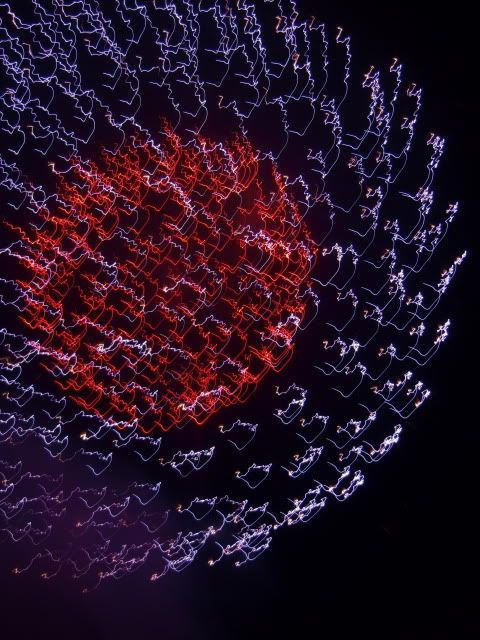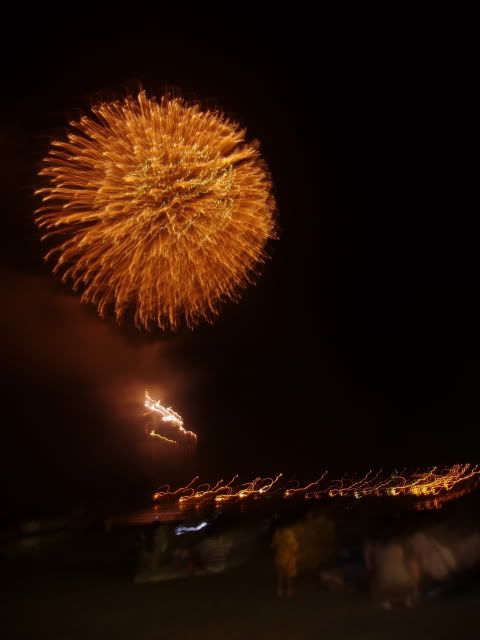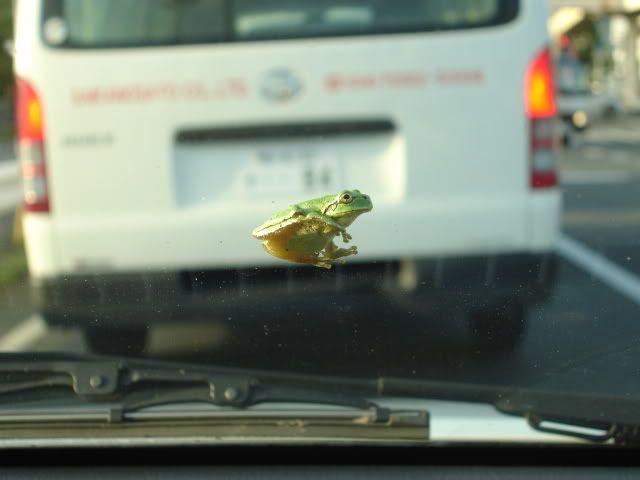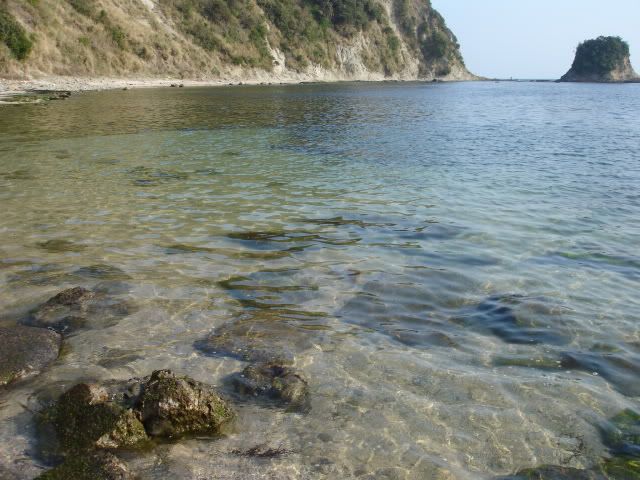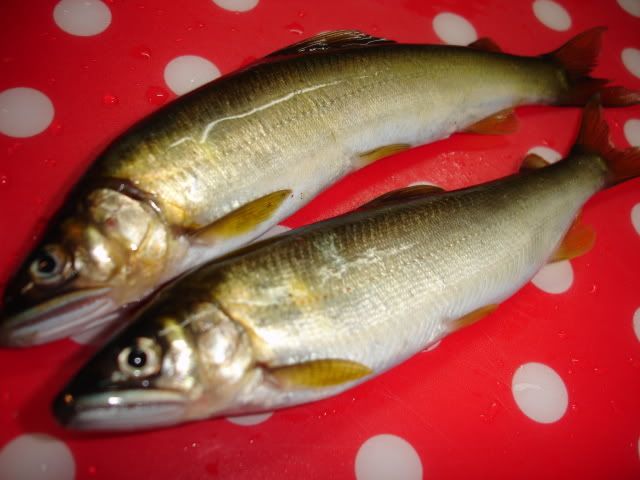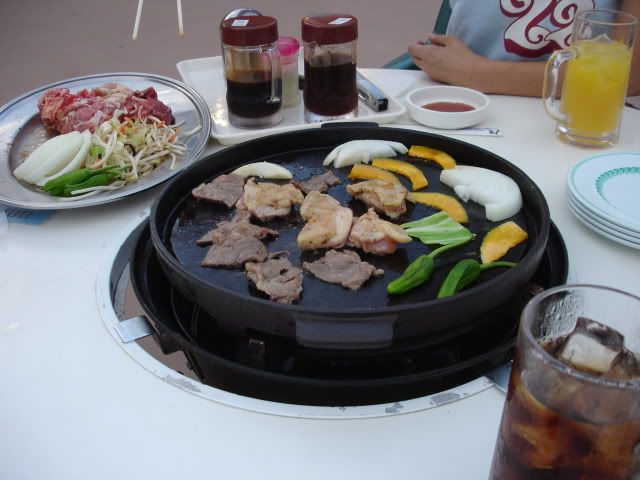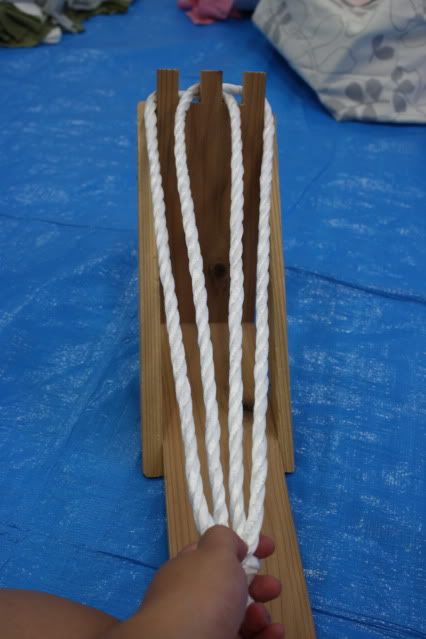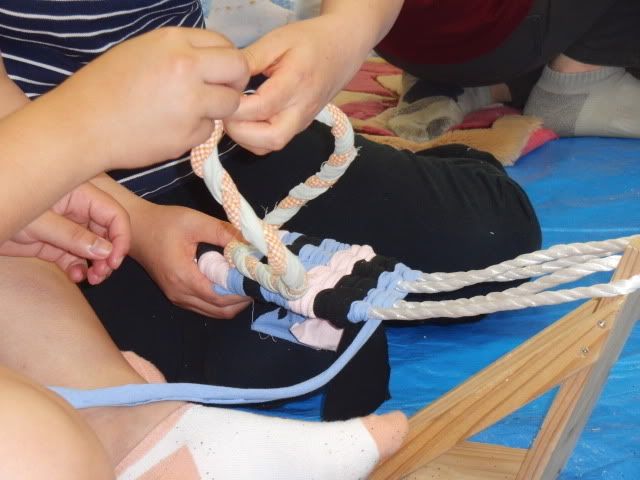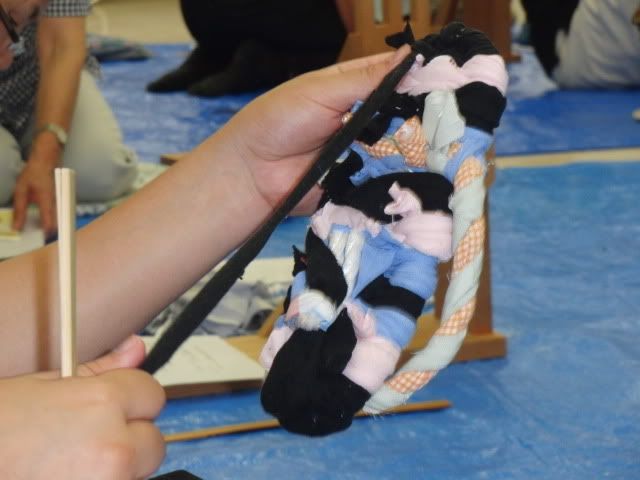Last night was my last living here in Kamogawa - I'll still be here for the next few days, but I'll be living out of my car/suitcase. In celebration? my friends and I went to see the Kamogawa fireworks! Many firework events have been canceled all over Japan because of the earthquake, so we were lucky to have an event so close by~.
Because of camera shake most of my photos didn't turn out well at all, but these few were at least...interesting?
And don't forget to stop by the yatai booths for yummy snacks!
Kamogawa summer still has much much more in store! Tonight I'll be heading out to the Amatsu District festival...assuming I can get some decent shots, I'll share them once the internet is installed at my new place~.
▼
Saturday, July 30, 2011
Monday, July 18, 2011
Wilderness survival?
Yesterday, I went fishing for ayu (sweetfish) with some of my coworkers for the second time ever (my first being last summer).
Ayu are river fish, and are said to only live in extremely clean waters. We went fishing in Kamogawa's Futama River, which is the only river in Chiba Prefecture that ayu can be found in - and even then, the number of rivers in Japan ayu can be found in are extremely limited.
I wish I had pictures to SHOW what the fishing process is actually like, but since it involves wading up and down the river (stream?)...which at many times had us in waist-deep water, not to mention while you are "stalking" the ayu you are crouched down in the river, I didn't think it was the smartest thing to bring my camera with me. I did managed to take a few photos with my cell phone afterwards though, which I'll post below.
Basically, we trudged through the Futama River for three straight hours, stalking spots where the ayu were gathered! Once we find such a spot, someone throws out the net to trap the ayu in a limited space.
Even after you technically trap them in the net, ayu are crafty little buggers, so they zoom around the water below the net and hide under rocks, leaves, etc. at the bottom of the river. They wait for that perfect moment when we move the net leaving the smallest opening...so that they can zoom right out to safety! It's almost amazing how well they are waiting and watching for that opportunity!
So since the ayu are usually too smart to get caught in the net when it is cast, the net only serves as a barrier to limit the places where they can run. You have to stare into the water really hard for the lightning fast movements, and pounce on them the milli-second you spot them (hence why you are continuously hunched down on fours in the river)! It's also difficult because there are a few other fish around too, so you have to try to differentiate between them so you don't waste your energy on the others.
Anyway, if/when you finally manage to catch one, you have to quickly deal the finishing blow by pinching the area between their eyes and gills. If you are too nice on them when you knock them out, they will run away the second they feel you relax, so you have to keep pinching until you feel something...pop? They squirm a ton and feel really slimy, so it's a slightly terrifying experience.
Last year, we caught over 100 fish. This year, there were considerable less ayu around, not to mention they were much smaller, so we only caught about 30. Effects of the earthquake???
There were 8 of us that day, so each person got to take home about 4 fish. I only took home 2 since lately I haven't even been home to cook/eat, but today I used them to make 鮎の塩焼き (grilled sweetfish seasoned with salt)~.
Such a simple activity, yet so extraordinary! This is what I love about living out in the countryside~.
Ayu are river fish, and are said to only live in extremely clean waters. We went fishing in Kamogawa's Futama River, which is the only river in Chiba Prefecture that ayu can be found in - and even then, the number of rivers in Japan ayu can be found in are extremely limited.
I wish I had pictures to SHOW what the fishing process is actually like, but since it involves wading up and down the river (stream?)...which at many times had us in waist-deep water, not to mention while you are "stalking" the ayu you are crouched down in the river, I didn't think it was the smartest thing to bring my camera with me. I did managed to take a few photos with my cell phone afterwards though, which I'll post below.
Basically, we trudged through the Futama River for three straight hours, stalking spots where the ayu were gathered! Once we find such a spot, someone throws out the net to trap the ayu in a limited space.
Even after you technically trap them in the net, ayu are crafty little buggers, so they zoom around the water below the net and hide under rocks, leaves, etc. at the bottom of the river. They wait for that perfect moment when we move the net leaving the smallest opening...so that they can zoom right out to safety! It's almost amazing how well they are waiting and watching for that opportunity!
So since the ayu are usually too smart to get caught in the net when it is cast, the net only serves as a barrier to limit the places where they can run. You have to stare into the water really hard for the lightning fast movements, and pounce on them the milli-second you spot them (hence why you are continuously hunched down on fours in the river)! It's also difficult because there are a few other fish around too, so you have to try to differentiate between them so you don't waste your energy on the others.
Anyway, if/when you finally manage to catch one, you have to quickly deal the finishing blow by pinching the area between their eyes and gills. If you are too nice on them when you knock them out, they will run away the second they feel you relax, so you have to keep pinching until you feel something...pop? They squirm a ton and feel really slimy, so it's a slightly terrifying experience.
 |
| Our haul for the day! |
 |
| But the fish we caught were still about the size of a person's hand! Not bad at all~. |
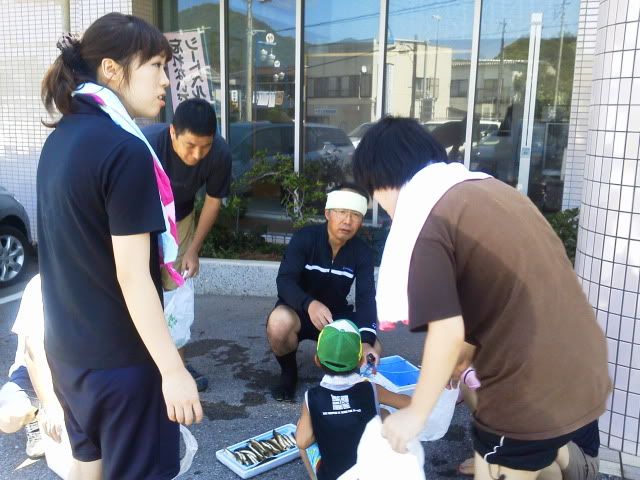 |
| Divvying up the catch! |
Such a simple activity, yet so extraordinary! This is what I love about living out in the countryside~.
Wednesday, July 13, 2011
Kamogawa Summer.
Rainy season is over!!!
With just a little over two weeks until my time here in Kamogawa comes to an end, things are getting pretty busy. This is also the busiest time of the year for Kamogawa, with beach season, summer vacation, fireworks, festivals...the list goes on and on, but all of these events are all held around the same time, during the summer months.
Below are some photos of a few of my favorite Kamogawa summer scenery, as well as some of the activities I'll be enjoying over the next couple of weeks!
During this time of the year, these mini frogs are everywhere. This is a photo I took awhile back because this little guy stuck to my windshield the entire time while I was driving to work one morning. I once saw one outside on the window of my office...which is on the 3rd floor. I always wonder how it got up there?? This photo makes the frog look decently big, but in reality they're probably not much bigger than an olive.
The rice crops seem to double in height by the day during this season! A couple more weeks and they'll be tall enough to look like they are rippling like waves when the wind blows.
It's extremely hot this year again, so I definitely am going to take advantage of the fact I live so close to the beach! Beach season in Kamogawa starts this Saturday, July 16, and runs until August 21!
This Saturday I'll be going to fish for ayu ("sweetfish")! Basically we'll be waddling around in the river (at certain points the water may be so deep that it comes up to your chest)...and catching these babies with our bare hands! I did it for the first time last summer and only managed to catch one fish (they're really slippery so if you aren't quick to deliver the final blow, they'll slither out of your hands in a blink of an eye!) so this year I want to hopefully catch more!
Summer = BBQ! The Kamogawa Sea World Hotel offers all-you-can-eat barbecue and all-you-can drink. I think the BBQ was originally for tourists, but it's super popular amongst locals too. I went 5 times last summer and I'll be going again next week!
Last but certainly not least, Kamogawa Fireworks!! This year it'll be held on Friday, July 29 at 7:30pm, at Maebara Beach. Tons of fireworks events have been canceled throughout the country, so even more reason to enjoy them this year. I don't have a good photo, but I love the 水上花火 (water surface fireworks)...just as the name says, the fireworks explode right on the surface of the water! Apparently Kamogawa is the only city on the Sotobo side of Chiba Prefecture that has these fireworks~.
I also really really want to go blueberry picking, which is usually from the beginning of July to mid-August! Anyone wanna go with me? :D
With just a little over two weeks until my time here in Kamogawa comes to an end, things are getting pretty busy. This is also the busiest time of the year for Kamogawa, with beach season, summer vacation, fireworks, festivals...the list goes on and on, but all of these events are all held around the same time, during the summer months.
Below are some photos of a few of my favorite Kamogawa summer scenery, as well as some of the activities I'll be enjoying over the next couple of weeks!
During this time of the year, these mini frogs are everywhere. This is a photo I took awhile back because this little guy stuck to my windshield the entire time while I was driving to work one morning. I once saw one outside on the window of my office...which is on the 3rd floor. I always wonder how it got up there?? This photo makes the frog look decently big, but in reality they're probably not much bigger than an olive.
The rice crops seem to double in height by the day during this season! A couple more weeks and they'll be tall enough to look like they are rippling like waves when the wind blows.
It's extremely hot this year again, so I definitely am going to take advantage of the fact I live so close to the beach! Beach season in Kamogawa starts this Saturday, July 16, and runs until August 21!
This Saturday I'll be going to fish for ayu ("sweetfish")! Basically we'll be waddling around in the river (at certain points the water may be so deep that it comes up to your chest)...and catching these babies with our bare hands! I did it for the first time last summer and only managed to catch one fish (they're really slippery so if you aren't quick to deliver the final blow, they'll slither out of your hands in a blink of an eye!) so this year I want to hopefully catch more!
Summer = BBQ! The Kamogawa Sea World Hotel offers all-you-can-eat barbecue and all-you-can drink. I think the BBQ was originally for tourists, but it's super popular amongst locals too. I went 5 times last summer and I'll be going again next week!
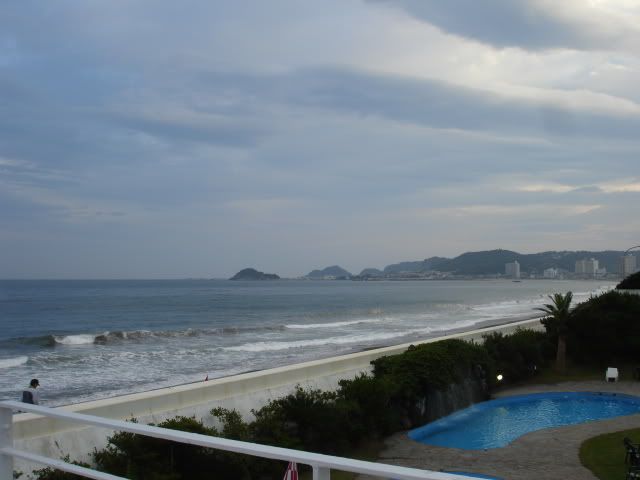 |
| The view as seen from the Sea World Hotel terrace, where the BBQ is. |
Last but certainly not least, Kamogawa Fireworks!! This year it'll be held on Friday, July 29 at 7:30pm, at Maebara Beach. Tons of fireworks events have been canceled throughout the country, so even more reason to enjoy them this year. I don't have a good photo, but I love the 水上花火 (water surface fireworks)...just as the name says, the fireworks explode right on the surface of the water! Apparently Kamogawa is the only city on the Sotobo side of Chiba Prefecture that has these fireworks~.
I also really really want to go blueberry picking, which is usually from the beginning of July to mid-August! Anyone wanna go with me? :D
Sunday, July 3, 2011
布ぞうり教室/Cloth Sandal Workshop!
Today I participated in a workshop teaching how to weave 布ぞうり, or Japanese cloth sandals! Back in the old days, they used to make these babies with straw - and here in Kamogawa, apparently they used to make elementary school students learn how to do it during class!
In recent years, it looks like making these out of cloth is gaining a lot of popularity, because you can cut up t-shirts, towels, etc. to make these sandals, "recycling" these items and therefore being environment-friendly! Plus, these are particularly comfy during the hot, humid summers, and they help you keep hardwood floors clean at home - the more you walk around with them on, the more you are wiping down your floors! And since they're made of cloth, you can throw them into the washer if they get dirty.
I took the below photos over the course of the workshop, but it's a confusing process at first so I don't think they serve very well for actually trying how to make these yourself...however, I did find a blog through google that documents/explains the process pretty well (http://ecosamurai.blogspot.com/search/label/Nuno-zori).
Technically we started with the thongs for the sandals, but they were actually already prepared for us. This is Suzuki-san teaching us how to make it at home though~.
Take 2 pieces of rope wrapped in cloth (like the ones Suzuki-san was making in the previous photo) and twist them together. They'll come into play much later.
Next, cut at least 3 adult-sized t-shirts into appr. 5cm strips!
The rope is pretty much the "frame" for the sandals...they certainly don't look anything like sandals yet, but you'll see! And the wooden contraption is basically a base to help you weave, but you can apparently use a hanger, or even your own two feet!
After making the front tip of the sandal (which is one of the most difficult parts of this process, I think), then you just constantly weave - 15cm, or a little over half of the sandal's final size. Make sure to stretch the sandal out horizontally as you weave, or else it might wind up being too narrow!
Once you've woven about 15cm of the sandal, you're ready to weave the tips of the thong into the sandal!
Keep weaving, gradually making what will eventually be the back tip of the sandal narrower as you go along.
Once your sandals are the appropriate length, you can take them off the wooden base. Pull the white rope taut until - voila! Your sandals are properly rounded off in the back.
Tie a shorter, thinner rope wrapped in cloth around the center of the thong - this will be the "nose" of the thong. Stab it through the center of the sandal (about 4cm away from the front tip), and tie it securely on the bottom side of the sandal. Trim any long pieces of cloth hanging out of the sandal! Leave just a little bit - as you wear the sandal, these pieces of cloth with naturally flatten themselves into the rest of the sandal...and then that's it!! You're all done~.
My completed sandals:
This takes up a lot of energy, but it's fun and strangely relaxing!!! I plan on trying again as soon as I dig out some more old shirts, etc. that I don't wear anymore :D
In recent years, it looks like making these out of cloth is gaining a lot of popularity, because you can cut up t-shirts, towels, etc. to make these sandals, "recycling" these items and therefore being environment-friendly! Plus, these are particularly comfy during the hot, humid summers, and they help you keep hardwood floors clean at home - the more you walk around with them on, the more you are wiping down your floors! And since they're made of cloth, you can throw them into the washer if they get dirty.
I took the below photos over the course of the workshop, but it's a confusing process at first so I don't think they serve very well for actually trying how to make these yourself...however, I did find a blog through google that documents/explains the process pretty well (http://ecosamurai.blogspot.com/search/label/Nuno-zori).
 |
| The instructor for the workshop, Suzuki-san! I met her last year when I did a similar workshop for my job. |
Take 2 pieces of rope wrapped in cloth (like the ones Suzuki-san was making in the previous photo) and twist them together. They'll come into play much later.
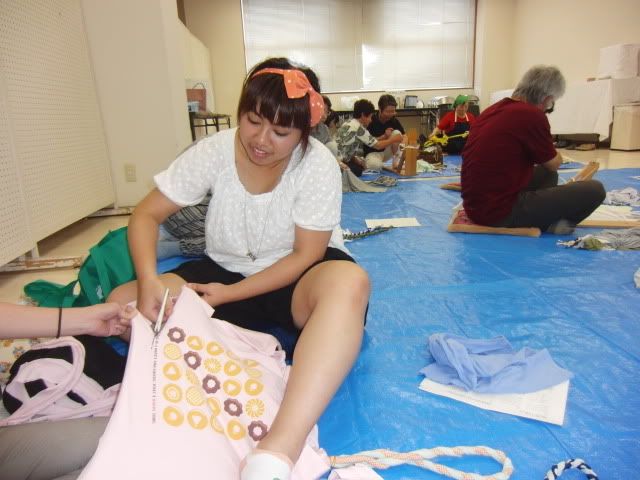 |
| Goodbye Mister Donut t-shirt D: |
The rope is pretty much the "frame" for the sandals...they certainly don't look anything like sandals yet, but you'll see! And the wooden contraption is basically a base to help you weave, but you can apparently use a hanger, or even your own two feet!
After making the front tip of the sandal (which is one of the most difficult parts of this process, I think), then you just constantly weave - 15cm, or a little over half of the sandal's final size. Make sure to stretch the sandal out horizontally as you weave, or else it might wind up being too narrow!
Once you've woven about 15cm of the sandal, you're ready to weave the tips of the thong into the sandal!
Keep weaving, gradually making what will eventually be the back tip of the sandal narrower as you go along.
 |
| Bug sandals? |
Tie a shorter, thinner rope wrapped in cloth around the center of the thong - this will be the "nose" of the thong. Stab it through the center of the sandal (about 4cm away from the front tip), and tie it securely on the bottom side of the sandal. Trim any long pieces of cloth hanging out of the sandal! Leave just a little bit - as you wear the sandal, these pieces of cloth with naturally flatten themselves into the rest of the sandal...and then that's it!! You're all done~.
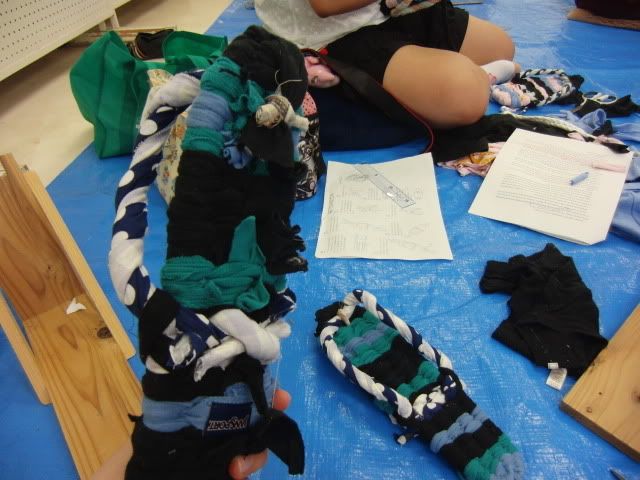 |
| All done!!! |
My completed sandals:
 |
| I chose calm? colors because I am planning to give these as a present to a certain someone <3 |
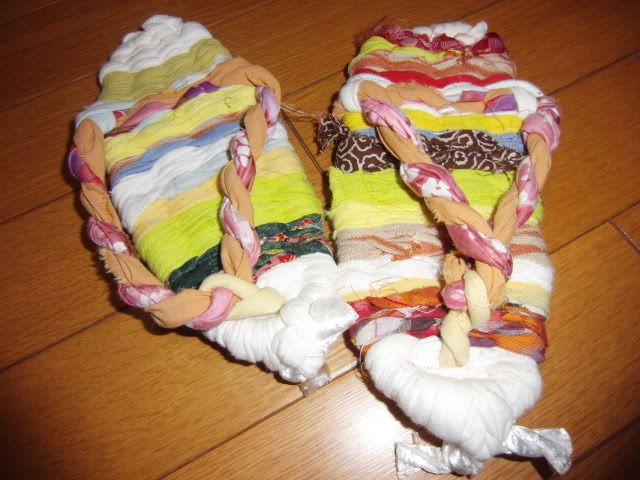 |
| These are the sandals I made last year. It's painfully obvious that the shape of each sandal is totally different from the other...but I do really enjoy the random colorfulness of this pair! |

